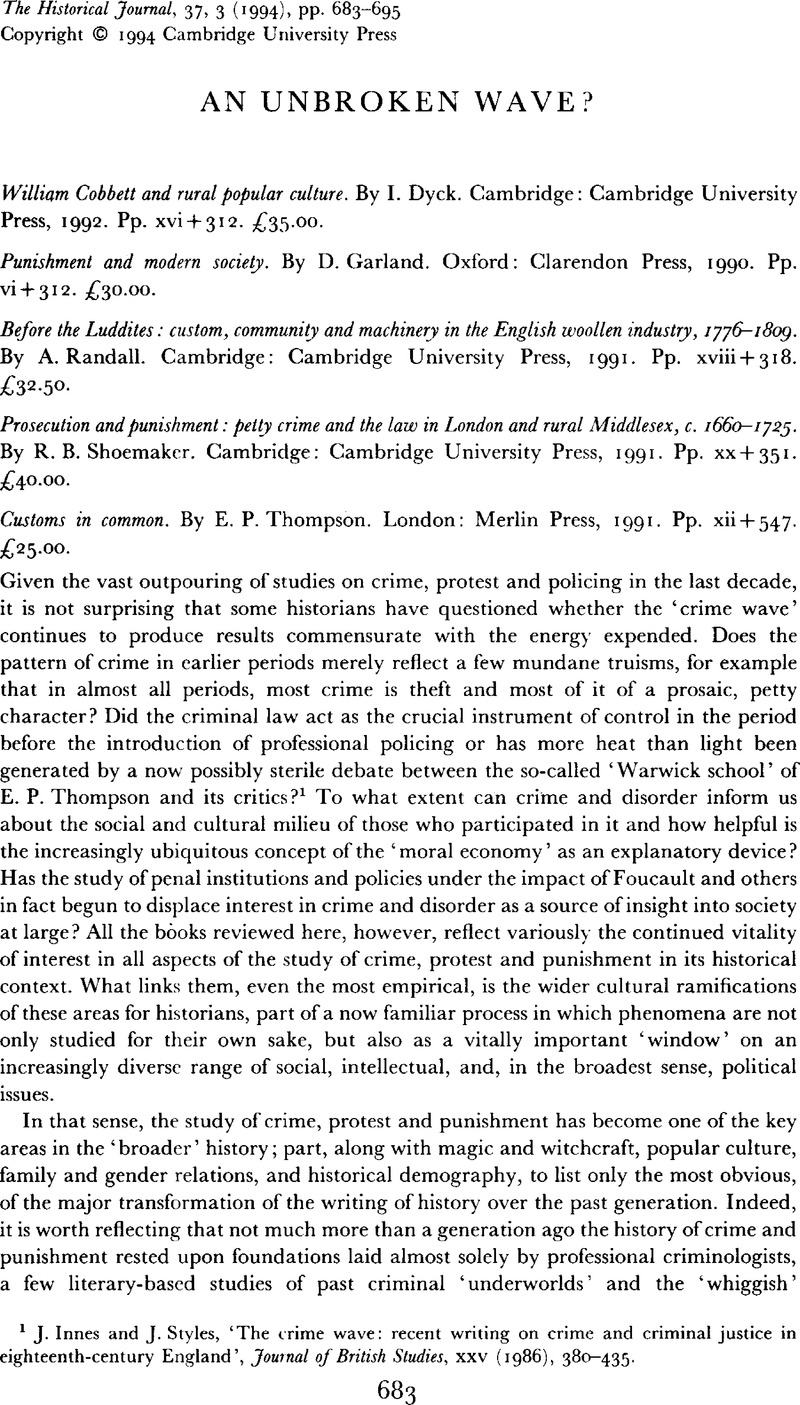Article contents
An unbroken wave?
Published online by Cambridge University Press: 11 February 2009
Abstract

- Type
- Review Articles
- Information
- Copyright
- Copyright © Cambridge University Press 1994
References
1 Innes, J. and Styles, J., ‘The crime wave: recent writing on crime and criminal justice in eighteenth-century England’, Journal of British Studies, XXV (1986), 380–435.CrossRefGoogle Scholar
2 See Radzinowicz, L., A history of the English criminal law (London, 1968)Google Scholar; Critchley, T. A., The conquest of violence: order and liberty in Britain (London, 1970).Google Scholar
3 Cobb, R., The police and the people: French popular protest, 1789–1820 (Oxford, 1970), p. 3.Google Scholar
4 J. L., and Hammond, B., The skilled labourer, 1760–1832 (London, 1919).Google Scholar
5 See Stevenson, J., Popular disturbances in England, 1700–1870 (London, 1979), pp. 129–31.Google Scholar
6 The mistranscription is of ‘Black Lamp’ for what is plainly, and repeated twice on the same folio, ‘Black Lump’, presumably referring to the large body of men collected at the meeting, see Sheffield City Record Office, Wentworth Woodhouse MSS, F45/80a, William Cookson to Earl Fitzwilliam, Aug. 1802.
7 See Stevenson, J., ‘The “moral economy” of the English crowd: myth and reality’, in Fletcher, A. J. and Stevenson, J. (eds.), Order and disorder in early modem England (Cambridge, 1985), pp. 218–38.CrossRefGoogle Scholar
8 Hobsbawm, E. J. and Rudé, G., Captain Swing (London, 1973), especially pp. 53–61.Google Scholar
9 See, for example, Ingram, M. J., ‘Ridings, rough music and the “reform of popular culture” in early modern England’, Past and Present, CV (1984), 79–113.CrossRefGoogle Scholar
10 See Thompson, E. P., The making of the English working class (2nd rev. edn, London, 1968), p. 73Google Scholar; Rudé, G., The crowd in history: a study of popular disturbances in France and England, 1730–1848 (New York, 1964)Google Scholar; Hobsbawm, E. J., Primitive rebels: studies in archaic forms of social movement in the 19th and 20th centuries (Manchester, 1959).Google Scholar
11 Thompson, E. P., ‘The moral economy of the English crowd in the eighteenth century’, Past and Present, L (1971), 76–136.CrossRefGoogle Scholar
12 Thompson, , ‘Moral economy’, pp. 77–8.Google Scholar
13 Thompson, , ‘Moral economy’, pp. 132–4.Google Scholar
14 Bohstedt, J., Riots and community politics in England and Wales, 1790–1810 (Cambridge, Mass., 1983).CrossRefGoogle Scholar
15 Stevenson, in Fletcher, and Stevenson, , Order and disorder, pp. 236–8.Google Scholar
16 Beattie, J. M., Crime and the courts in England, 1660–1800 (Princeton, 1986), p. 470.Google Scholar
17 Beattie, J. M., ‘Violence and society in early modern England’, in Doob, A. and Greenspan, E. (eds.), Perspectives in criminal law (Aurora, 1984).Google Scholar
- 2
- Cited by


